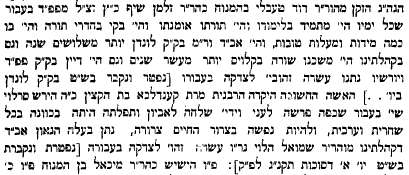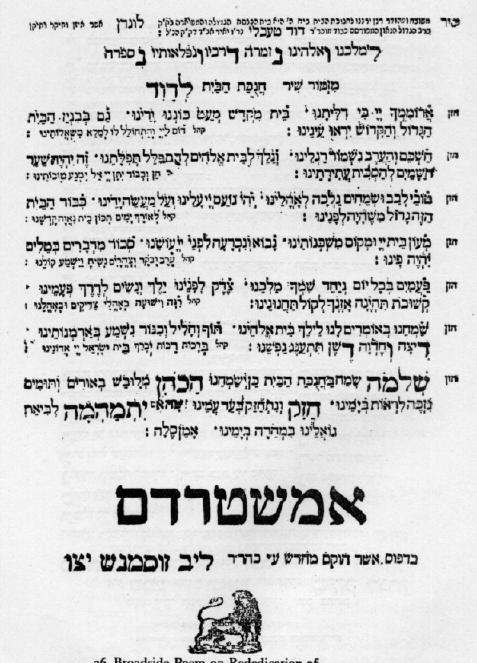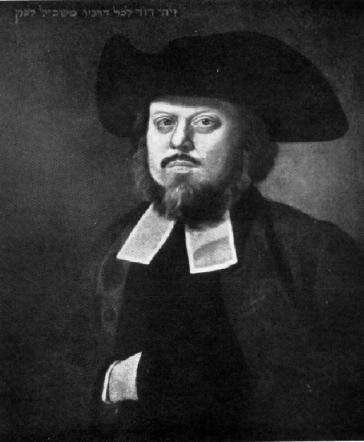These services were "composed in Hebrew" by the rabbi The Rev. David Solomon Shiff, "High Priest of the Said Synagogue," otherwise known as David Tevele Schiff (or רבי דוד טעבלי כ"ץ שיף). Rabbi Schiff (1715?-1791) was the Chief Rabbi of the Ashkenazim (although this was not an official position yet) from 1765 until his death.
As an aside, some have wondered at the oddity of early British Chief Rabbis styled as "High Priest" of the Jews by the British press. I wonder if this tradition (carried on most especially through his eventual successor, Rabbi Solomon Hirschell) was not in some way due to the fact that Schiff was a kohen. Sometimes in overly flowery rabbinic salutations a kohen might be addressed as a כהן הגדול, lit. "Great Priest," but very similar in construct to the original Hebrew for "High Priest," כהן גדול. Maybe some such letter was seen and gave birth to this quasi title. Or, perhaps the mere fact that he was a kohen and was the rabbi, or head, of the congregation is what gave rise to it.
Rabbi Schiff had a distinguished rabbinic career on the continent, holding respected positions in Worms andFrankfurt A.M. Here is how he (and his wife) were listed in the Worms Memorial Book (printed in Kobetz al Yad v.3):

His most famous student is undoubtedly Rabbi Nosson Adler, one of the primary teachers of the Chasam Sofer. In the introduction to Mishnas Rabbi Nathan he is described as one of Rabbi Adler's three rabbis, alongside the author of Penei Yehoshua (who was a rebbe of Schiff as well) and Rabbi Moshe Rapp. However, only Rabbi Schiff is called his רבו מובהק. Both rabbi and student published nothing in their lifetime. However, each of them had a great work recording their teachings published posthumously. Rabbi Schiff's לשון זהב was published in 1822, and Rabbi Adler's משנת רבי נתן was published in 1862. Rabbi Markus Horovitz showed, in volume 4 pg. 39 of Frankfurter Rabbinen, that many explanations in Mishnas Rabbi Nathan are the same as in Leshon Zahav, suggesting that Rabbi Nosson Adler faithfully taught Torah which he received from his rebbe. [1]
This prayer service begins with the sifrei Torah being brought into the synagogue from a side room, under a canopy. While they are brought in, the people are to say ברוך הבא בשם ה. The Torahs are deposited into the aron. Prior to mincha, the chazzan is instructed to recite a special piyut composed by Rabbi Schiff. The piyut forms two acrostics woven together. One consists of verses beginning with the letters which spell out דוד טעבלי ברבי שלמה זלמן כהן, and the other is the order of the אלפא ביתא. Although you can see the entire piyut in the Scribd document, I will include one line right here, because it is interesting. It reads במדינה זאת הקים אדונינו המלך שארש השלישי על שכמו המשרה/ As in this country, where George the Third sways the sceptre (as translated by Levi, who notes that the Hebrew is "the government is on his shoulders"). Thus, Rabbi Schiff transliterated George as שארש in Hebrew.
After the reading of this poem, the Torahs are brought out and a series of seven hakafos, circuitous processions were to take place, while seven especially chosen psalms are recited. Afterward, the Torahs are returned to the aron. Then another piyut was to be recited, this one also written by Rabbi Schiff, but recycled from its use in the dedication of the Great Synagogue in 1766 (that time Handel's "Coronation Anthem" was performed, and Rabbi Schiff recited prayers in English - which he never mastered, although more on that below). In 1766 this prayer was printed in Amsterdam as a special broadside:

Afterward, a special poem was to be recited in honor of the woman responsible for it all, Judith Levy, who had provided the most money for the construction. The poem is an acrostic of her name, יטה בת משה זל - the service gives no indication who wrote it, but presumably it was Schiff.
Then, three sifrei Torah were to be removed from the aron, and the Chazzan, while holding one Torah, with two others on his right and left, is to intone the הנותן תשועה למלכים prayer for governments. As it is printed, it appears that while the prayer was said in Hebrew, the English phrases "Our sovereign Lord King George the Third" and "Our most gracious Queen Charlotte," etc. were recited in English.
After the prayer for the King and Queen, a Mi Sheberach was to be recited in honor of Judith Levy, where the sum of her donation was read - בעבור שנדבה ארבעה אלפים ליטרות שטערלינ לבנין בית הכנסת הזה - four thousand pounds, which was a gazillion dollars in those days. Finally, the three seforim were to be returned to the aron and the Chazzan and his choir were to sing the joyous and musical Psalm 150 with mincha, and probably Kabbalat Shabbat following.
Thus, the road to Pressburg (i.e., the Chasam Sofer's שלשלת הקבלה) did begin, in part, through a Reverend High Priest who composed a unique prayer service for the dedication of his synagogue.
Since he was a rabbi in London for almost 27 years - the Worms yizkor book is mistaken in writing that it was 30 years - what of Rabbi Schiff's English? As I mentioned before, when the Great Synagogue was enlarged and rededicated in 1766, Rabbi Schiff recited a prayer in English - but that could have been coached and memorized. The truth is that at the beginning of his career in London, and probably at the end too, the vast majority of congregants probably conversed among themselves in Western Yiddish. The first time it occurred to this congregation to require its rabbi to know English was as late as 1842, when it embarked on a search for a successor to Rabbi Solomon Hirschell. One of the conditions was that whomever was elected would learn to speak English withing one year - as it happens, Rabbi David Tevele Schiff's sister's grandson was appointed, another rabbi named Nathan Adler. Although I'm sure it would have required its Chief Rabbi to speak English 10 years earlier too, and probably also 20 years earlier - it is a fact that when Rabbi Solomon became Chief Rabbi 40 years earlier no one thought that acquiring English was necessary (although he of course did acquire at least some English).
Thus it does not seem that in the 1760s, and possibly as late as 1790, there was any special reason for Rabbi Schiff to have bothered learning English. However, you can't live for decades in a country without picking up some of the language anyway. A few interesting personal letters of his were published by Charles Duschinsky, most to his brother. Naturally they are written in an admixture of rabbinic Hebrew and Western Yiddish. Duschinsky points out that in a few places he uses English words (e.g., פאוועראבל for "favourable" or פארטיקלאר, "particular"). With regards to his skill in English, Duschinsky points out that David Levi "had to" translate the pamphlet highlighted in this post to English but I don't think we can use this as proof one way or another. Although I agree that he probably did not have a good English, even if he spoke a decent English that would not make him capable of translating Hebrew poems - even composed by himself - into English. Furthermore, that's not the sort of task one would expect of a learned rabbi of the time, and the title page said that David Levi was commissioned to translate it by the order of the lay leadership of the shul. Even were Schiff perfectly capable of translating or composing in English, one would expect someone else to do the translation.
Finally, some time ago I posted about an 18th century responsum from Holland which mentions a donation by famous Colonial Jewish-American Haym Solomon (link). In the comments the question was raised, how can we be certain that the "famous donor Chaim of Philadelphia" was Haym Solomon? It turns out the proof was published more than 70 years ago in an article when a 1784 correspondence between Haym Solomon and Rabbi Schiff was printed in the AJHS journal by Hyman B. Grinstein, titled "A Haym Salomon Letter to Rabbi David Tevele Schiff, London, 1784." In this fine Hebrew and Yiddish letter Solomon, addressing Rabbi Schiff as ידיד בכל דרכי' משכיל, mentions sending money to the same Gumpel Wolfenbuttel to whom the responsum in my prior post was addressed. Here too Solomon mentions giving money to him. In short, he was Haym Salomon's go-to guy in Europe. Thus, there is no doubt that it is the famous Haym Solomon mentioned in the responsum in the Pene Aryeh (the author of PA was a contender for Chief Rabbi of London after R. Schiff died, which gives you an idea of how intertwined the rabbinic elite were in those times).
The letter was not written by Solomon himself, as apparently his education did not enable him to compose a Hebrew letter. However, on the theme of Englishisms, the letter is headed with the following: קאפּי מן ז' אלול, that is Copy [of the original letter] made on 7 Elul [1784].
Here is Rabbi David Tevele Schiff's portrait:

[1] It occurs to me that something may be worth investigating. As is well known, Rabbi Nosson Adler maintained the unique practice - or non-practice - of not writing down his Torah thoughts. The reason he gave for this was his prodigious memory. He felt that since he did not forget any of his Torah thoughts that the dispensation to write Torah she-be-al peh did not apply to him. How then do we know what he taught? Not from his writings, but from his students. How did it come about that the publisher of Mishnas Rabbi Nathan had a Mishnah commentary of Rabbi Nosson Adler to publish? The publisher, Rabbi B.H. Auerbach's, father was a student of Rabbi Adler. Thus, according to Rabbi Auerbach, these teachings of Rabbi Nathan Adler were taught to him by his father.
Now, I am definitely not accusing Rabbi Auerbach of manufacturing this, but since he has already been indicted (if not convicted) as a literary forger (link) one might say that the Mishnas Rabbi Nathan is in need of authentication, and one wonders if the way to authenticate it is not to note that many of the teachings are the same as those in Leshon Zahav, by his rebbe, which Auerbach could have seen, but if some of these teachings are also found among other students of Rabbi Adler. The Chasam Sofer famously maintained that he only taught that which he received from his teachers. Putting aside whether or not this was an exaggeration, are parallels to Mishnas Rabbi Nathan to be found in his writings? What about those of other students of Rabbi Adler? - living students, whom I may add, were probably in short supply in 1862, if any were still alive at all (Rabbi Nosson died in 1800). In short, since Rabbi Auerbach unfortunately is not above suspicion, and since a brilliant forger could well have decided to base some of it on the verifiable teachings of Rabbi Adler's rebbe, it would be interesting to see if these teachings have been, or could be, confirmed through the writings of other students of Rabbi Adler. Of course these could also be a source for such a forgery so long as they were published prior to 1862, but at least we might have further independent confirmation of what Rabbi Adler's teachings were.
UPDATE: In the comments a reader points out that the primary accuser of Rabbi Auerbach as a forger already accused him of forging Mishnas Rabbi Nosson as well - almost exactly 100 years ago.
